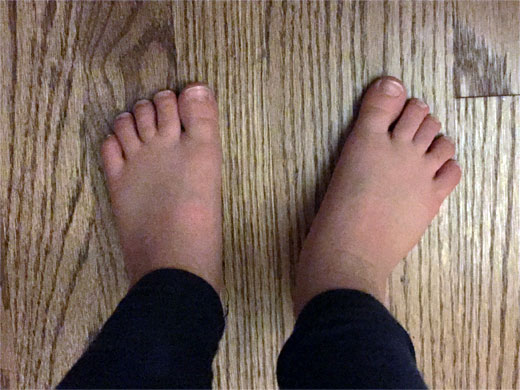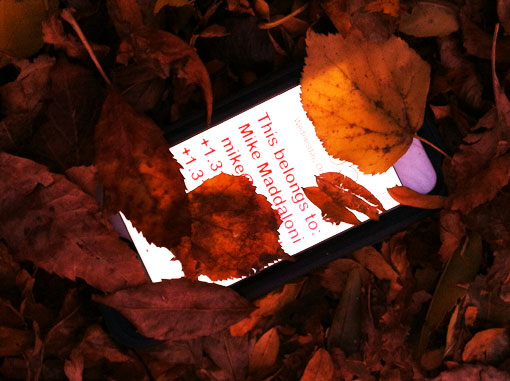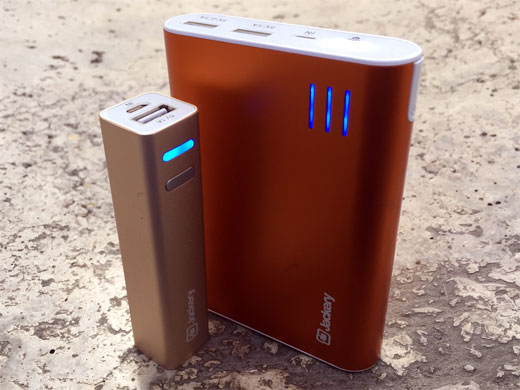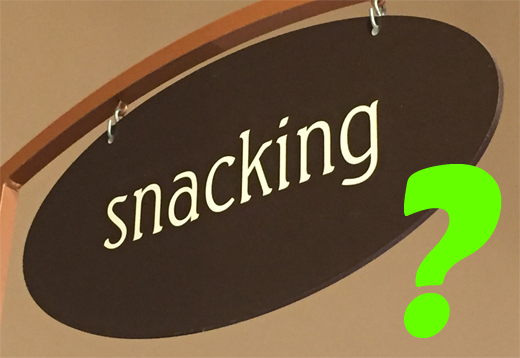Jackery Battery Chargers Big And Small Do The Job
Once upon a time you could easily remove the battery from a mobile device. This made it easy to keep a charge as you could simply swap out a dead battery for a fresh one. Of course you would have to charge the removed battery, and you could either charge it in the device or in a special battery charger.
Where the above scenario sounds like ancient history, it was less than a decade ago that you could do this. Today most mobile devices have non-removable batteries. Granted “non-removable” is a relative term as you can remove anything, it’s just that the device isn’t designed for it to be easily removed, and in doing so may void its warranty. As a result, spare batteries have been replaced by external battery chargers, and have spawned a whole new industry, especially as having 1 or 2 seems to never be enough power.
Recently I was offered the chance to evaluate external battery chargers made by Jackery. Where I have seen this brand before, namely on Amazon.com, I had never used one. In this eval I was also offered to choose which battery charger I would like to try. As I couldn’t choose between their largest and smallest models, the Giant + and the Mini, I asked if I could try both, and they said I could.
In my review I didn’t plan out anything specific, as I simply wanted to use them as I would any battery charger. I also had my wife use them as well, not specifically saying why I had them. Also note I am not an electrician, and I can’t speak to power ratings or usage, only from a lay person’s point of view. Judging from most people who read The Hot Iron, I am not disappointing anyone with that last statement.
Giant + – Multiple devices, multiple charges
The Giant + is a battery charger you most likely won’t carry in your pocket, this is unless you’re going to a festival concert, which I did this past fall when I took it to Riot Fest. I also have used it to charge multiple device at home, such as my iPhone and iPad. It was also the power source for my modern-day attempt at a boom-box, charging both my iPhone and a Bluetooth speaker which played at our neighborhood block party.
The main features of the Giant + are that you can charge 2 devices at once, and that you can charge devices multiple times. In my charging, I was far from scientific, but many times I had multiple devices charging to 100% at once. There is a 3-bar light indicator which tells you the battery level, and the accompanying charge cable would replenish the battery pretty quickly – at least overnight, which is what I most often did.
Another feature of the Giant + is an LED flashlight. By pressing a side button twice, the flashlight turns on and off. I’ll admit I didn’t really use this in a real-world situation, as I always had enough light, typically from device screens, to plug in to it. But I did try the light in the dark and it is plenty bright. As it’s not a battery you may typically carry around with you, I am not sure if the light often used, but I would love to hear from someone who has.
Mini – Topping off the fuel tank
As I said before, I have several battery chargers, namely as all of my devices have weak batteries and constantly need recharging. Where I have used the Giant + to bring a device back from the dead, sometimes it’s nice just to top off a charge or have a spare battery just in case. The Jackery Mini came in handy for both situations.
The Mini is just that – small, compact and can easily fit in the same pocket as your device… that is, if your device can fit in your pocket itself, but I digress. This battery is one my wife would take with her to charge her phone. It has a push button where up to 4 LEDs illuminate in extremely bright blue to indicate the strength. I have also kept the Mini in my backpack with a spare charging cable if I ever needed a top-off.
Solid and stylish
Both the Jackery Giant + and Mini are solid. They have an aluminum outer shell with a shine to them – the Giant + I had is bright orange (a color I love!) and the Mini was close to what Apple calls “rose gold” but they call it just gold. I of course have dropped both batteries, and they have held up well, though they mostly just fell off my desk.
As for the price, I have seen a variety of ranges, and as I am posting this close to Black Friday and Cyber Monday, I am sure there will be deals on it. In all cases, the Giant + is more than the Mini.
For portable power, these backup batteries from Jackery performed well for me. They also offer many other styles, as well as cases. And after having them hands-on, I am glad I couldn’t decide which one to review, as they each have their own uses. If you have used Jackery backup batteries before, or have any questions on these, I would like to hear from you in the comments to this post.
This is from The Hot Iron, a journal on business and technology by Mike Maddaloni.
Did you enjoy this? Subscribe to The Hot Iron by RSS/XML feed or Read by Email.
Mobile Technology • Technology • Thrive • (0) Comments • Permalink
First 2 Steps To Take To Start Blogging

As follow-up to my inquisitive and popular blog post on 2 questions I ask anyone thinking about blogging, namely to those who are still interested in blogging after reading it, I now would like to offer advice on how to get started with your blog.
First, setup a free blog at Wordpress.com
You need a blog in order to blog. A blog is a Web site with a content management system (or CMS) which is software on a Web server that allows you to easily publish what you write.
If you have been to a blog site before, there is a good chance it’s on Wordpress, as it is the most well-known and used blog CMS. Wordpress can be used for entire Web sites as well, and not just blogs, but we won’t get ahead of ourselves too much here. Another reason for using Wordpress.com is in its portability potential. If you build a blog at Wordpress.com and in the future you decide you want to move it to another Web host, you can literally export the site and move it. Note I have oversimplified how I described this process and some technical expertise is involved.
Plus, creating a blog at Wordpress.com is free, so if you start one and realize it’s too much for you, there is no major financial commitment.
Register and set a domain name for your blog
Where I just got done telling you to create a free blog, now I am recommending you spend a little more on a domain name.
By registering a domain name for your blog and tying it to your Wordpress.com blog, you gain in several ways. By default, your blog will be named something like myblogname.wordpress.com, but myblogname.com is a more unique name and easier to remember. Also, if you decide to move your blog in the future, you can keep the same Web address – you will not be able to keep myblogname.wordpress.com as that is not your own domain name, wordpress.com.
A domain name also a unique name to your blog. Where it may be presumptive that your blog will be a runaway smash hit on the Internet. If you have peered around The Hot Iron there are plenty of articles on getting your own domain name and other benefits of doing so. You can register a domain name many places, and I always recommend name.com and note I did not get paid to say that!
Ready to blog in no time
Setting up a blog on Wordpress.com and registering a domain name can all be done in under an hour. Configuring your blog and performing some customizations may take a little longer, and that all depends on how much you want to do, though I wouldn’t focus too much on the look of your blog and rather on its substance – the writing!
I hope this has helped, and please share a comment to this post once you do it and share the link to your new blog for all to see.
This is from The Hot Iron, a journal on business and technology by Mike Maddaloni.
Did you enjoy this? Subscribe to The Hot Iron by RSS/XML feed or Read by Email.
Blogging • Build • Technology • Web Design • (0) Comments • Permalink
My Takeaways From The Book Evolutionary Eating By Dr. Theresa Nesbitt
Over the summer I was seriously considering weight and diet counseling. As, well, let's just say I need to lose a few pounds, and with the increasing demand of little kids – plus the fact I am not getting any younger – it was more than time to take action.
When I talked with a colleague who is also a doctor about this, he asked me if, before I committed time and money to a program, I could commit US $15 on a book. As you cant even get a mediocre mixed drink in some Chicago bars for that, I said, “why not?” It was then that he recommended I read a book written by a friend of his, Dr. Theresa Nesbitt, titled Evolutionary Eating: How We Got Fat and 7 Simple Fixes.
As the book was recommended by someone I trust, I bought it. But I have to admit – by the title alone, which I thought was cliché for a health book, I probably wouldn't have otherwise bought it. But I did, and I am glad I did. And it has worked for me too, but I will save that for the end of this post.
So it is probably needless to say that I had several take-aways from this book, and here's some of the top ones I'd like to share:
We Never Really Learned Everything About Eating – Looking back on growing up, plus raising my own little angels, most of what we teach our kids about eating is more logistical – use utensils, don't put food in your hair, chew with your mouth closed – but we don't have as much focus on when to eat, what to eat and why.
Eat 3 Meals A Day At Routine Times – By eating consistently, or as consistently as possible, your body “knows” when to process food coming in and when to process stored fat, and by doing so you will use that excess stored energy and lose weight. I had an uncle who did this, eating 3 meals a day of the food he grew and raised and he lived to his mid 90's.
Keep It Real By Eating Real Food – Stick to basic and real foods and less or no processed or manufactured foods, or as Dr. Nesbitt calls “food forgeries” as our bodies are built for processing natural foods and not artificial or manufactured ingredients, flavors and additives. The original TV chef, Julia Child, always cooked with real butter, lard and wine and she lived to her 90's as well.
No Snacking – If you eat 3 meals a day only, you are thereby not snacking. Of course this goes beyond everything out there in society, at least modern American society. This for me has been personally tough, especially with earlier said angels who are ever growing and snacking. But by me snacking I too am ever growing, but in a bad way, and by not snacking, that has subsided.
How Vegetable Oil Is Made – Vegetable oil is supposed to be better than other oils, but they don't necessarily squeeze veggies to get the oil, unlike with olive oil. A chemical process is used to get it, and where the book introduces this I have done my own research as well. I'll stick with olive oil, or as I have been doing, I will forego oil altogether and use a variety of natural foods to add flavor.
Any Change Requires Willpower – This is probably the only thing I disagree with the author on. She states that by learning how to eat better, no willpower is involved. For someone like myself who has been eating the same way for almost half a century, willpower isn't only involved, it is direly needed! In the past I have lost weight, but always ate the same, and then it was more involved with a high level of exercise. When I stopped exercising, the weight came right back.
Some of these are of the 7 “simple fixes” that Dr. Nesbitt offers, and if you are intrigued as to what they all are, I recommend getting a copy of this book. As for the book as a whole, it is a very good and easy read – not intense, educational and supportive with a touch of humor, all the while not being too preachy. I recommend Evolutionary Eating not only for someone looking to lose weight, but for anyone looking to eat better or to support someone losing weight.
As for myself, I read the book over summer and it really resonated with me. I have changed my diet quite a bit, eating more salads without dressing, and cutting out most all breads. I still eat pizza and pasta, but I try to eat less of it. It has been far from perfect, and sometimes a struggle, but when I am hungry a coffee or seltzer will do the trick. Since simmer, I have lost about 25 pounds. I have a lot more to lose, but I am pleased with the results so far!
I have shared this book with my immediate family, and have given my copy to a friend. If you read Evolutionary Eating, I welcome your thoughts on it in the comments of this post.
This is from The Hot Iron, a journal on business and technology by Mike Maddaloni.
Did you enjoy this? Subscribe to The Hot Iron by RSS/XML feed or Read by Email
Book Take-Aways • Strategize • Thrive • (0) Comments • PermalinkWeb Content Horror Stories For Halloween

Come gather children and adults, huddle by the flickering fire, sip on hot apple cider, all while I, in the shadowy light of the fire, tell stories this Halloween season – true stories, horror stories of Web site content!
The Scream
Many, many years ago I worked for a tech consulting firm that was undergoing rebranding. This exciting process was to include a new look to the Web site. As we were in the business of building Web sites, we were going to build out the ability to maintain the site as well. Note this was years before the term content management system, or CMS, was ever in vogue.
The project was assigned to myself and another senior guy I will call Rocky. There was a little bit of competitiveness between us, partly due to our own cockiness and confidence in our abilities, not to mention he was a Packers fan and I was a Patriots fan, but I digress. In some regards I think that's why both of us were put on the project. We would be building the technology, integrating the new branding and graphic design from the marketing firm and designing sample content, as the president of the company would be writing all of the content, as this is what he told us.
Despite our attitudes, Rocky and I worked very well together. We built out the front-end, back-end, database and sample “lorem ipsum” content. And we did it all on time.
Here's where the story gets scary... the president asked to meet with us at a predefined time in the project plan to review our progress. To his surprise – which quickly and surprising to us we saw on his face – we showed him a, for the most part, complete Web site. All it would need is a few small adjustments... and a lot of content.
Though we were in a brightly-lit office, the room got suddenly dark and eerie. The typically congenial voice of the president got heavy and creepy. Then, timed with a hypothetical clap of thunder, the screaming began.
As time and attempts to forget about this have clouded specifics, in general our frightening leader said, “how dare you finish on time when I didn't even start to write the content!” What? We were numb to the proverbial “second one” he was ripping into us, and it seemed like hours afterwards we were still stunned. Then, after he left, we laughed, hysterically, for what also seemed like hours.
The Original Blank Page
It was a work day like any other, multitasking away in and on my Web consulting business. A friendly chime sounded as my often co-collaborator and an amazing graphic designer n her own right – we'll cal her Sierra – called as we were partnering on a Web site proposal. It was mostly written, reviewing back and forth by email, and we were meeting to make a final walkthrough together before submitting it to the prospective client.
As we went through the proposal line-by-line, word-by-word, it was almost as if a light springy piano tune was playing in the background by none other than Liberace himself. As we got through the end of the document, where we listed references and example Web sites, we both paused as we were reviewing the list. Even though we were on the phone, over 1,500 miles apart, it was as if we were in the same room, pointing to the same spot in the document.
Just as Sierra began to say what I was thinking, it was as if Liberace was vaporized to dust and the Phantom of the Opera took over at the bench and with the flick of some switch, the piano became a pipe organ, and the Phantom played the most sinister music known. Then Sierra spoke, "THIS Web site... when was the last time you looked at it?” The silence over the phone was broken by more organ music, which was timed with each of us typing the Web site's URL into our Web browsers.
As we navigated beyond the home page the music got louder and more daunting, as we looked at empty page after empty page, with nothing on them at all – not one word of content! The shrieking in our voices was beyond our control. This Web site had been live for almost a year with several completely blank pages, to which we could not believe. My gut reaction took over, as I logged into the CMS for the site and placed some basic “coming soon” messages. There was no way we could use this great looking Web site with blank sub-pages as an example of the great work we did. Where the placeholder text was not the ideal situation, it was really all we could do, and in the end turned out to be sufficient as we won the proposal.
Only a Few of Many Stories
Over the years I have encountered Web content horror stories, almost from the time I started creating Web sites. I share these stories not to criticize people or to make fun of them, rather to serve as a cautionary tale of the importance of content development for Web sites. It is not something to do casually – or not at all – and is vital to the success of your site.
Boo!
This is from The Hot Iron, a journal on business and technology by Mike Maddaloni.
Did you enjoy this? Subscribe to The Hot Iron by RSS/XML feed or Read by Email.
Blogging • Build • Business • Strategize • Web Design • (0) Comments • Permalink
Put Your Smartphone Lock Screen To Work To Save Your Device

Whenever someone gets a new or upgraded mobile device, the first thing they do is customize it. From app icon placement to wallpaper images, they do all that they can to make it suit their needs... or ego, or both.
I’d like to share a mobile customization that you can easily do, and it can help you get your device back in case it is ever lost or stolen – customize the lock (or security) screen with your contact information.
It Works!
This idea is actually nothing new for me, as it dates back before I had an iPhone, and even back before I had a Nokia – going back to almost 6 years when I had a Palm 680 smartphone. In those golden years, the lock screen of the Palm allowed you to customize a text message, of which I did with with my name, phone and email address. All was good until one night when I was running late to do the lights and sounds for a friend’s improv show, and in the process of running from the train to the theater, I dropped my Palm device. This I didn’t realize until right before the show started, as I reached to silence a device that was not there. As I had my contact info right there when the kid who found it turned it on, he was able to email me, and we met the next day to get my phone back. Phew!
Create Your Own Image
With today’s popular phones, you can do this with customizing the background image – or wallpaper – on the phone’s lock screen, as you can see that I did on the above photo of my iPhone. In this case, I used PhotoShop, the graphic design software, to create an image to fit on the lock screen, and added the text I wanted. If you don’t have graphic design software, you can still do this a variety of ways, including these tips for the iPhone, Android or Windows Phone. If this is beyond your tech savviness threshold, you can just print out a piece of paper with your info on it, take a picture of it, and save it as the lock screen wallpaper.
But Wait, What About Find My Phone Apps?
Yes Virginia, there are apps and core functionality of devices that allow you to track your device using GPS. And yes, these apps can work to help you retrieve your device. But if someone finds your phone, and when turning it on sees you name, this can be a deterrent to them to whatever nefarious things they may have considered doing to it. Plus they may even get in touch with you prior to you yourself realizing it is missing or can get to a computer to use that find function.
Will You?
Sometimes the simplest solution is the most effective. Your lock screen doesn’t have to be as simple as mine – it can have style, and your contact information as well. If this has convinced you to create a custom lock screen, please let me know in the comments to this post. As well, if you would never consider doing this, I’d like to know that too.
This is from The Hot Iron, a journal on business and technology by Mike Maddaloni.
Did you enjoy this? Subscribe to The Hot Iron by RSS/XML feed or Read by Email.
Build • Mobile Technology • Strategize • Technology • Web Design • (0) Comments • Permalink





